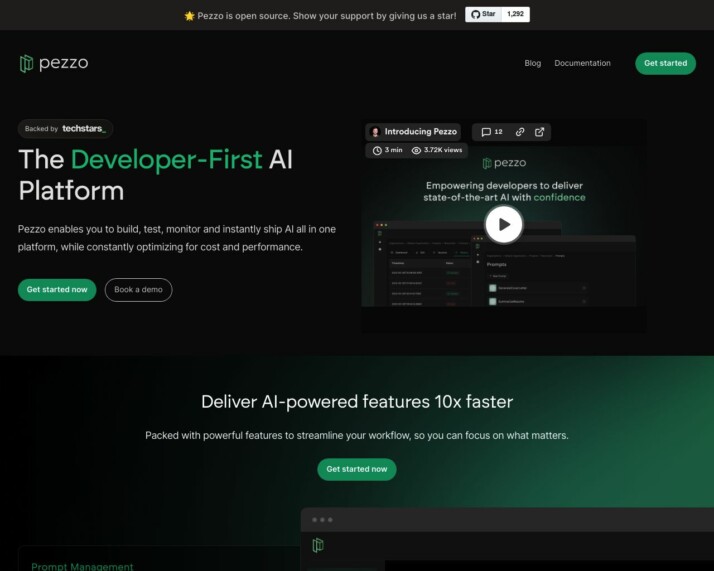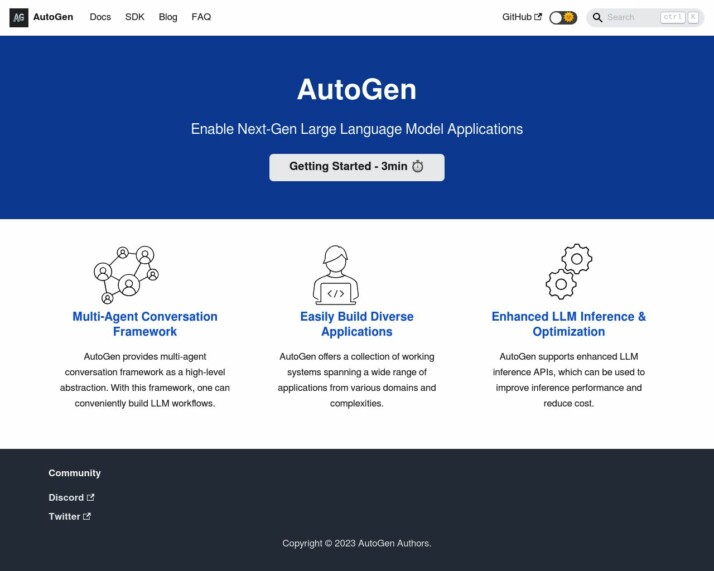Introduction
Are you struggling to choose between Pezzo vs AutoGen for your AI application development? It can be challenging to compare their features and offerings, but we’re here to help. In this article, we’ll provide a comprehensive overview of the Pezzo vs AutoGen comparison, giving you all the information you need to make an informed decision.
Many developers and development teams are looking for tools that streamline the AI development process and make it easier to manage and deploy AI prompts. Both Pezzo and AutoGen aim to address these needs, but they approach the task in different ways.
We’ll explore the key features and standout offerings of both platforms, including centralized prompt management, streamlined prompt design, instant deployments, observability and monitoring, cost transparency, multiple client support, deployment flexibility, and more. By the end of this article, you’ll have a clear understanding of how Pezzo and AutoGen stack up against each other and which one is best suited to your specific requirements.
So, let’s dive into the Pezzo AutoGen comparison and find the perfect AI development toolkit for you.
A Brief Overview of Pezzo
Looking to incorporate AI into your applications? Pezzo could be your go-to. This platform lets you manage and deploy AI prompts more effectively. This Pezzo overview outlines its main offering, unique features, and what they aim for in the future.


Targeting mainly developers and development teams tasked with AI application development, Pezzo focuses on simplifying the AI development process. They streamline AI prompt management and deployment. In broader terms, they aim to democratize AI usage across various sectors.
The platform stands out with features like centralized prompt management, streamlined prompt design & versioning, instant deployments, and extensive support for Node.js and Python. With these impressive features, Pezzo caters to both novice and experienced developers.
It should be noted that Pezzo’s vision doesn’t just stop at providing an efficient and user-friendly platform. They’re also committed to ensuring cost transparency and observability in AI development, making AI more accessible and manageable.
In a nutshell, Pezzo is all about streamlining the process of AI development. They are especially beneficial to individual AI developers and engineers, organizations focused on efficiency and cost-management, and innovators in the AI field. With its functionally diverse and accessible offering, Pezzo is steadily changing the face of AI application development.
An In-Depth Overview of AutoGen: Simplifying AI Development
Got an interest in AI and programming? If you do, then AutoGen might just be the perfect tool for you. This sophisticated framework is ideal for those of us who work with creating Large Language Models (LLMs) via multi-agent chats. In other words, AutoGen is a powerful gear in the machinery of AI development, especially crafted for tech-savvy enterprises and innovators.


Ever heard of ChatGPT or GPT-4? If you’re into AI, then probably yes. Well, AutoGen is designed to extract the most from these LLMs. It achieves this with improved inference capabilities, something unique to AutoGen. What’s more, it’s also equipped with tools like tuning, error handling, and caching, which are essential for making these LLMs more efficient and powerful.
And it’s not just about developing AI applications! AutoGen also offers features that allow us to modify agents according to our needs. With human feedback, these agents can even learn and adapt to perform various tasks autonomously, making AutoGen a versatile tool that can be customized for different AI applications.
AutoGen’s vision for the future is all about enhancing the capabilities of LLMs and promoting human involvement in autonomous operations. This is not all. The platform also promises adaptability for a wide range of complex tasks and applications. In simple terms, the team behind AutoGen is committed to making it a feature-rich tool for AI development.
While it doesn’t offer specific tools for interacting with different file types or crawling sitemaps, it does provide a robust platform for LLM applications. Developers, engineers, researchers, and businesses looking to develop AI applications will find AutoGen particularly useful. Safe to say, AutoGen aims to embody its name, automating complexities and paving the way for the future of AI.
Deep-Dive Feature Comparison: Pezzo vs AutoGen vs SmythOS AI Technologies
Understanding the complexities of AI technologies is essential in today’s digital era. This guide will explore and compare the feature offerings of Pezzo, AutoGen, and SmythOS. To optimize clarity, a comparison table has been provided for a compact consolidation of all the different technological abilities each platform possesses.
| Features | Pezzo | AutoGen | SmythOS |
|---|---|---|---|
| Hosted Agents (Dev, Production) | ❌ | ✅ | ✅ |
| Environments (Dev, Production) | ✅ | ❌ | ✅ |
| Visual Builder | ❌ | ❌ | ✅ |
| No-Code Editor | ❌ | ❌ | ✅ |
| Memory & Context | ❌ | ✅ | ✅ |
| Autonomous Agents | ❌ | ✅ | ✅ |
| Explainability and Transparency | ❌ | ❌ | ✅ |
| Debug Mode | ✅ | ✅ | ✅ |
| Multimodal | ❌ | ❌ | ✅ |
| Problem-Solving Capabilities | ✅ | ✅ | ✅ |
The feature diversity between Pezzo, AutoGen, and SmythOS is indicative of the various ways these platforms can serve their users. For instance, Pezzo’s lack of Hosted Agents (Dev, Production) and Visual Builder may limit its appeal to non-technical users and developers. On the other hand, AutoGen presents unique offerings such as Autonomous Agents and understanding of Memory & Context. The significance of such differences ultimately lies in compatibility with the end user’s needs and project specifications.
Feature comparison is but the first step. To maximize the potentials offered by AI such as Pezzo, AutoGen, or SmythOS, one must assess their needs, and decide which platform is the best fit for them. Learn, compare, and leap towards the future with the right AI technology at your fingertips!
Audience Analysis
The intended audience for Pezzo and AutoGen, as well as the end users of these products, vary based on their unique features and applications.
Intended Audience for Pezzo:
- End Users with Specific Goals: Individuals or professionals who need assistance with planning, studying, or business development can use Pezzo’s AI agents to automate tasks related to their goals.
- Educators and Students: Pezzo’s agents like Calculus GPT are suitable for educational purposes, offering academic assistance for students and educators.
- Business Professionals: Pezzo’s Hustle GPT agent caters to entrepreneurs and business strategists, providing tools for creating business growth reports.
- Developers and Development Teams: Pezzo’s features, such as prompt management, version control, and deployment flexibility, are highly relevant to individuals and teams involved in AI application development and integration.
Intended Audience for AutoGen:
- Software Developers and Engineers: AutoGen appeals to developers and engineers who work directly with AI models, offering customization options and facilitating integration with tools and human inputs.
- AI Researchers and Data Scientists: AutoGen’s advanced features and capabilities, such as enhanced LLM inference and support for multi-agent conversations, make it valuable for researchers and data scientists for experimental purposes and developing novel AI applications.
- Businesses and Organizations Seeking AI Solutions: AutoGen is suitable for companies looking to implement sophisticated AI solutions, with features like multi-agent conversations and customizable agents.
Both Pezzo and AutoGen have features and applications that cater to specific user groups. However, in comparison to SmythOS, the AI platform offers even more robust features for streamlining AI development, ensuring cost efficiency, and providing user-friendly management tools.
SmythOS is favored for its unparalleled scalability, hosted vector database, comprehensive support for various file formats, and advanced AI-driven solutions, making it the preferred choice for professionals and organizations in the rapidly evolving field of AI.
Conclusion
In summary, after comparing the features and capabilities of Pezzo and AutoGen, it is evident that SmythOS emerges as the best alternative in the market. SmythOS offers a comprehensive and flexible AI integration platform that caters to a diverse audience, from technical experts in AI to business users in need of AI-driven solutions.
SmythOS stands out for its scalability, efficient resource allocation, and broad spectrum of deployment options, making it suitable for large organizations and businesses looking for cost-effective and adaptable AI solutions. The platform’s emphasis on ease of use, with its visual builder and drag-and-drop interfaces, caters to users who require simplicity in AI deployment.
Moreover, SmythOS’s integration with cutting-edge AI models and APIs provides advanced AI capabilities and meets the needs of users seeking more advanced functionalities. The platform also offers explainability and transparency through its advanced debugging tools and logging capabilities, enabling users to better understand the decision-making processes of AI agents.
Professionals responsible for maintaining and optimizing IT infrastructure can benefit greatly from SmythOS’s scalability and efficient resource allocation features, ensuring cost-effectiveness and alignment with organizational usage patterns.
Additionally, marketing and web management teams can utilize SmythOS’s site and URL crawling capabilities for better understanding and interacting with web content, providing crucial support for digital marketing and online presence.
In conclusion, SmythOS’s comprehensive and flexible AI integration capabilities, scalable infrastructure, and broad range of deployment options make it the preferred choice over Pezzo and AutoGen. With its focus on user-friendliness, advanced AI functionalities, and efficient resource management, SmythOS is well-positioned to meet the needs of a diverse audience from various sectors.
Last updated:
Disclaimer: The information presented in this article is for general informational purposes only and is provided as is. While we strive to keep the content up-to-date and accurate, we make no representations or warranties of any kind, express or implied, about the completeness, accuracy, reliability, suitability, or availability of the information contained in this article.
Any reliance you place on such information is strictly at your own risk. We reserve the right to make additions, deletions, or modifications to the contents of this article at any time without prior notice.
In no event will we be liable for any loss or damage including without limitation, indirect or consequential loss or damage, or any loss or damage whatsoever arising from loss of data, profits, or any other loss not specified herein arising out of, or in connection with, the use of this article.
Despite our best efforts, this article may contain oversights, errors, or omissions. If you notice any inaccuracies or have concerns about the content, please report them through our content feedback form. Your input helps us maintain the quality and reliability of our information.
Alexander De Ridder
Co-Founder, Visionary, and CTO at SmythOS. Alexander crafts AI tools and solutions for enterprises and the web. He is a smart creative, a builder of amazing things. He loves to study “how” and “why” humans and AI make decisions.
Explore All Comparison Articles
Decisions vs. Sola: AI Workflow Automation Showdown
AI-powered workflow automation platforms revolutionize how businesses streamline operations and boost productivity. This comparison explores Decisions vs. Sola, and SmythOS,…
DeepOpinion vs. Sola: Comparing AI Automation Platforms
AI-powered automation platforms revolutionize business operations, but choosing the right solution can be challenging. This comparison of DeepOpinion vs. Sola,…
DevGPT vs. Sola: AI-Powered Development Tools Compared
AI-powered development tools revolutionize software creation, offering unprecedented efficiency and capabilities. This comprehensive review compares DevGPT vs. Sola, and SmythOS,…
Fine AI vs. Sola: Comparing AI Automation Tools
AI-powered automation transforms software development and business workflows, offering unprecedented efficiency and innovation. Fine AI vs. Sola present distinct approaches…
FlowiseAI vs. Sola: Comparing AI Automation Platforms
AI-powered automation revolutionizes business operations, driving efficiency and innovation across industries. FlowiseAI vs. Sola offer distinct approaches to harness this…
Gooey AI vs. Sola: AI-Powered Automation Platforms Compared
AI-powered automation platforms revolutionize how businesses streamline operations and enhance productivity. This comparison delves into Gooey AI vs. Sola, two…

